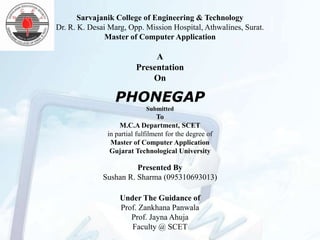All About Phonegap
- 1. Sarvajanik College of Engineering & Technology Dr. R. K. Desai Marg, Opp. Mission Hospital, Athwalines, Surat. Master of Computer Application A Presentation On PHONEGAP Submitted To M.C.A Department, SCET in partial fulfilment for the degree of Master of Computer Application Gujarat Technological University Presented By Sushan R. Sharma (095310693013) Under The Guidance of Prof. Zankhana Panwala Prof. Jayna Ahuja Faculty @ SCET
- 2. Sushan R. Sharma 0953010693013 PhoneGap Bridging the gap between the web and mobile devices
- 3. AGENDUM ï PhoneGap: Inception ï Introducing PhoneGap ï What Is PHONEGAP? ï Why PhoneGap? ï Cross Platform Mobile Development ï How PhoneGap Works? ï The PhoneGap BUILD Service ï Advantages of using PhoneGap ï Disadvantages of using PhoneGap ï Conclusion ï References 3
- 4. PHONEGAP: INCEPTION ï There's a storm brewing between Web-based and native app developers and it's time to pick a side... ï âNativeâ Apps: Written in a programming language for a targeted operating system ïķApple iOS Devices: iOS SDK, using Objective-C ïķAndroid Devices: Android SDK, using Java ï Webâ Apps: Web-based applications written with traditional web programming languages ïķHTML/CSS, JavaScript, PHP/.NET/JSP 4
- 5. 5
- 6. Introducing PhoneGap!!!! ï Applications built with PhoneGap are not just like normal mobile web sites. ï PhoneGap applications are able to interact with mobile device hardware, such as the Accelerometer or GPS, in ways that are unavailable to normal web applications. ï PhoneGap applications are also built and packaged like native applications, meaning that they can be distributed through the Apple App Store or the Android Market. 6
- 7. So What Is PHONEGAP??? Phonegap is an open-source mobile development framework developed by Nitobi Software and IBM. It enables all mobile developers to build applications for mobile devices using JavaScript, HTML and CSS. 7
- 8. Why PhoneGap??? ï Mobile development is a mess. Building applications for each device--iPhone, Android, Windows Mobile etc requires different frameworks and languages. One day, the big players in mobile may decide to work together and unify third-party app development processes. ï Until then, PhoneGap will use standards-based web technologies to bridge web applications and mobile devices. Plus, because PhoneGap apps are standards compliant, theyâre future-proofed to work with browsers as they evolve. ï PhoneGap is an open source implementation of open standards. That means developers and companies can use PhoneGap for mobile applications that are free, commercial, open source, or any combination of these. 8
- 9. CROSS PLATFORM MOBILE DEVELOPMENT Blackberry Web OS Android Windowsphone7 iPhone PhoneGap Symbian 9
- 10. HOW PHONEGAP WORKS??? ï Build your app once with web-standards. ï Based on HTML5, PhoneGap leverages web technologies developers already know best... HTML and JavaScript. ï Wrap it with PhoneGap ï Using the free open source framework or PhoneGap build you can get access to native APIs. ï Deploy to multiple platforms! ï PhoneGap uses standards-based web technologies to bridge web applications and mobile devices. 10
- 11. HOW PHONEGAP WORKS?(Conti.) 11
- 12. Glance On The PHONEGAP BUILD Service Using PhoneGap we can create Build Native Web-apps. 12
- 13. Glance On The PHONEGAP BUILD Service(Conti.) There are some things the web does very well. There are also some things native apps do very well. PhoneGap aims for the union of these. ï Write app using HTML, CSS or JavaScript. ï Upload it to the PhoneGap Build service. ï Get back app-store ready apps for Apple iOS Android, Palm, Symbian and BlackBerry. ï Current development to also support Windows, MeeGo and Bada. ï PhoneGap Build service is currently in beta testing and is free to register and use will remain free for open source projects. 13
- 14. With PhoneGap you can, 14
- 15. Advantages of using PhoneGap ï You can use the single codebase for your cross platform applications. ï You can leverage the hardware specific features such as Geolocation, Vibration, Accelerometer, Contact Support and Sound. ï Open source â can be altered or extended by anyone. ï Open Source community is actively contributing new modules which can potentially save you time and money. ï Requires knowledge of common web technologies (HTML, CSS, JavaScript) rather than multiple distinct mobile platforms. ï Currently offers the widest major platform coverage among other similar frameworks. 15
- 16. Limitations of using PhoneGap ï Since PhoneGap is designed to support multiple platforms, it will not have the new features available as soon as they are available in the SDK. Essentially, it is always catching up. ï Several platform core features may still not be available via PhoneGap. ï Just like any other Open Source platform / SDK, PhoneGap heavily relies on the community to contribute various modules. ï While these modules will work fine out of box, there may be challenges with the support and maintenance with those modules. 16
- 17. Conclusion ï Platform-specific native applications seem to be slowly fading away into a niche or need-basis. ï HTML/JS is easier to deal with than Java (fact!) ï If you want to produce an app and/or deploy to multiple platforms at reasonable cost then PhoneGap is the way to go. 17
- 18. References ïAndrew Lunny, âPHONEGAP Beginnerâs Guideâ, 2011 Packt Publishing ïURL: https://www.phonegap.com ïURL: http://mobile.tutsplus.com/tutorials/phonega p/phonegap- ïURL: https://www.docstoc.com/docs/62696875/Ph oneGap 18
- 19. 19



















